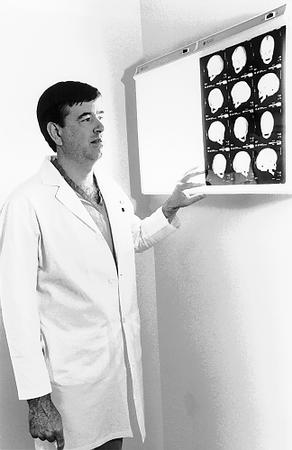
Dr. Kevin Kelly perfomed the state's first surgery using dissolvable plastic, instead of metal, to repair a child's skull deformities
New surgery uses plastic to repair child's skull deformities
Vanderbilt University Medical Center's Department of Plastic Surgery is the first in the state to implant dissolvable plastic plates and screws to hold a child's delicate cranial bones together – an alternative to traditional metal plates and screws, which are often visible under the skin and may cause future problems.
A four-month-old DeKalb County girl was recently the first patient to receive the new plastic hardware at VUMC. She underwent surgery to repair skull deformities resulting from craniosynostosis, the early closure of one or more of the joints between the bones of the cranium. In the DeKalb County youngster's case, openings in her skull that would allow room for growth fused together prematurely, a circumstance that occurs in one of every 3,000 births.
The tiny plastic plates were used on another infant here last week, and physicians believe at least one youngster each week will benefit from the new technology. The plastic plates have been shown to dissolve in nine to 14 months.
"There was hope all around the world that there could be some way to make plates heavy enough to hold the bone together, then dissolve," said Dr. Kevin J. Kelly, assistant professor of Plastic Surgery.
"Researchers have been working on this material for years and finally came up with just the right chemical composition that will remain stiff enough so the plate can hold two pieces of bone in place, but not so brittle to snap apart when the screws are tightened."
The FDA-approved polymer of glycolic and lactic acid has finally been proven to offer both of those qualities, he said. The material is similar to that which has long been used for dissolving sutures.
"The biggest problem in developing the material with just the right chemical composition was that when you started getting mixes of that polymer stiff enough to hold a bone into position, it had a tendency not to dissolve," he said.
Kelly said the new plates and screws are used more often in children than adults. Adult bone is heavier, and there is less concern about skeletal growth, he explained.
The new material is especially beneficial for bone repair in the facial skeleton. VUMC is home to the state's largest craniofacial center. More than 50 pediatric craniofacial reconstructions are done here each year, along with 25 to 30 more cases of pediatric facial trauma.
"The bones in a child's face are so small and delicate. They've been able to make the plates tiny enough so they will dissolve in a reasonable amount of time, yet still give the strength and resilience to hold the bones in position until they heal," Kelly said.
They are especially useful for cranial reconstructions, such as the four-month-old child's, where the skull is reshaped by rearranging cut bones.
"The titanium plates we have always used are very small, but they won't dissolve," Kelly said. "They have caused difficulty on occasion. Some children have developed knots on their brows from the metal plates and screws. Others can fall and bump the plate, which may actually irritate the skin. That could require another operation to go back in and remove the plate."
Kelly said that plates only serve a purpose for four to six weeks, or until the bone has had a chance to heal.
"So having something that will dissolve and be completely eliminated from the system certainly eliminates some of the problems the metal could create," he said.
The plastic material will also be used on facial fractures in children at VUMC.
Another advantage to using plastic for facial reconstruction cases in children is that after bones have healed, the child's face continues to grow.
"If the metal plates are in there, the skeleton changes around the plates in children. But metal plates are stationary. They can't change. They can't shift. There is the potential for forming facial scars or divots where the plates are located. We believe if the plates dissolve, they won't leave behind any residual problem."
Kelly said there were no major negative effects during the one and one-half years that this particular material was tested.
"We don't have a 20-year follow up yet. We do know, however, there were problems with the titanium plates, so this is an attempt to make something that was good, better," Kelly said.
"We're in the early stages of using this material. It's a new technology. Who knows what will happen in 10 to 15 years. As time goes on, it will be refined. They will eventually be smaller and will dissolve more rapidly. Only time will tell."













